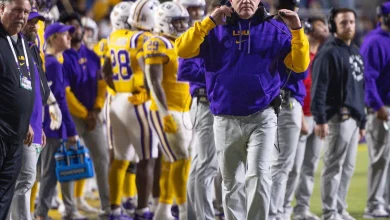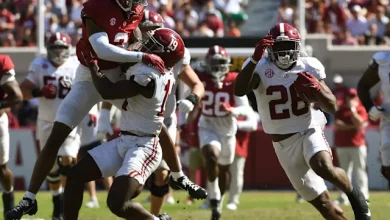“Use your eyes to catch the ball!” And what? Coach Mike Denbrock of Notre Dame football discusses.

Coach Mike Denbrock, the offensive coordinator for Notre Dame Football, has often been heard shouting a simple but powerful piece of advice: “Use your eyes to catch the ball!” This phrase may seem almost too basic at first, but it speaks to the essence of football mechanics, player development, and the mental focus needed to excel in the game. In a sport where precision and reaction time are critical, especially for skill players like wide receivers and running backs, Coach Denbrock’s statement reflects his emphasis on proper technique, mental clarity, and the essential fundamentals of catching the football.
At first glance, this phrase could be perceived as a minor detail in the grand scheme of the game. However, in Coach Denbrock’s philosophy, it holds a much deeper meaning—one that can impact not only an individual player’s performance but the overall success of an entire offense. In this article, we will break down Coach Denbrock’s approach to teaching receivers how to catch, how focus and vision play pivotal roles, and why this fundamental lesson is a cornerstone of Notre Dame’s offensive game plan.
The Role of “Eyes” in Catching the Ball
At its core, football catching involves a combination of physical skills and mental focus. Players need strong hands, good timing, and solid positioning, but these elements can only come together if the player is properly attuned to where the ball is at all times. This is where the “eyes” come into play. When Coach Denbrock says, “Use your eyes to catch the ball,” he’s referring not only to the physical act of looking at the ball as it comes in but also to the broader concept of tracking the ball from release to catch, staying engaged mentally with the trajectory, and making adjustments on the fly.
In a high-speed game like football, it’s easy for a receiver to become distracted, whether by defenders, the crowd, or their own thoughts. However, the most successful receivers are the ones who are able to stay focused, follow the flight of the ball, and adjust their body accordingly. This skill is often referred to as “tracking the ball,” and it’s one of the most important components of a successful catch. Without proper tracking, even the most talented players can miss opportunities, leading to drops, miscommunications, and incomplete passes.
Denbrock’s emphasis on using the eyes to catch the ball reinforces the idea that mental focus is just as important as physical ability. By keeping the eyes locked in on the ball from release to catch, a receiver can ensure they’re in the best position to make the catch. This attention to detail is what separates average receivers from great ones, and it’s a key point in Denbrock’s coaching philosophy.
The Mental Focus Behind Catching
Coach Denbrock’s coaching philosophy is not just about physical drills—it’s about mental preparation. Successful football players must cultivate a mindset that allows them to tune out distractions, maintain focus under pressure, and react quickly to ever-changing circumstances. For receivers, the mental aspect of catching the ball is paramount, and Coach Denbrock’s use of the phrase “Use your eyes to catch the ball” directly correlates with the need for mental clarity and focus.
One of the main reasons why many drops occur in football, particularly in high-stakes situations, is a lack of concentration. Receivers can become distracted by outside elements, such as the crowd noise, the anticipation of contact from defenders, or even their own thoughts about the next play. This mental lapse can cause a player to lose focus on the ball’s trajectory and result in a missed catch. Coach Denbrock’s approach aims to train players to block out these distractions and focus solely on the ball, allowing them to make cleaner, more confident catches.
To illustrate the importance of mental focus, consider a wide receiver who is about to catch a pass in the middle of a game. The receiver may be facing tight coverage, the defense may be pressing him, and the crowd may be making noise. The ball is coming in fast, and the receiver’s job is to ensure that they track the ball all the way into their hands without being distracted by any of the external factors. By reminding players to “use their eyes,” Coach Denbrock is encouraging them to ignore the distractions and focus on the single task at hand: catching the football.
This level of focus requires preparation. Denbrock’s coaching involves drills that enhance players’ concentration and mental toughness. For instance, drills such as tracking tennis balls or practicing with different types of throws can sharpen a receiver’s ability to track a football under various conditions. These exercises don’t just focus on the physical aspect of catching but also on honing the mental aspect of maintaining concentration and focus.
The Link Between Hands and Eyes in Catching
Another crucial element that Coach Denbrock emphasizes is the connection between the eyes and the hands. When catching the ball, receivers must not only track the ball with their eyes but also engage their hands properly to secure the catch. The mechanics of this are incredibly important, as the hands are the final link in the process of catching the football.
Coach Denbrock’s statement about using the eyes to catch the ball isn’t just an admonition to focus on the ball—it’s a reminder to keep the eyes and hands aligned to ensure a successful catch. The hands should follow where the eyes are looking, so the player’s body is in sync with the ball. When the eyes lock onto the ball, the hands naturally adjust, and the player is more likely to catch the ball cleanly.
One of the most basic drills that Denbrock implements for his receivers is the “eyes and hands” drill. In this drill, players are instructed to keep their eyes on the ball and track its movement, while also ensuring that their hands are positioned correctly for the catch. The drill forces players to create muscle memory that ensures they always look at the ball first, and then react with their hands. Denbrock believes that when players are fully engaged in the process of catching with both their eyes and hands, they can reduce drops and increase their catching consistency.
The Challenge of Catching in Pressure Situations
Football is a sport built on high-pressure moments, and receivers often find themselves in situations where they must make critical catches in front of tens of thousands of fans. Whether it’s a fourth-quarter, game-winning touchdown or a crucial third-down conversion, the mental and physical demands on a receiver are significant.
This is where the power of focus comes into play. The best receivers are those who thrive under pressure, and Denbrock’s coaching philosophy helps develop that ability. By emphasizing the importance of using the eyes to catch the ball, Denbrock is teaching his players how to stay calm, collected, and focused on the fundamentals, even in the most chaotic moments of the game.
One notable example of a player who has excelled under Denbrock’s tutelage is Notre Dame’s current star wide receiver, who has been able to make game-changing catches in critical moments. By staying focused on the ball and maintaining a clear mental picture of the catch, this player has managed to perform consistently in high-pressure situations, a testament to the effectiveness of Denbrock’s teaching methods.
The Role of the Quarterback and Timing
Of course, catching the ball is not solely a responsibility of the receiver. The quarterback’s role in the equation is just as important. Denbrock emphasizes the synergy between the receiver’s eyes and the quarterback’s timing. The quarterback must deliver the ball in a manner that allows the receiver to track and catch it with ease. The combination of the receiver’s focus and the quarterback’s precision is key to a successful passing play.
During practices, Denbrock ensures that the timing between quarterback and receiver is on point, emphasizing the importance of trust and chemistry. The receiver must know when and where the ball is coming, while the quarterback must rely on the receiver’s ability to track the ball and make the catch. This relationship is built through repetition, mental preparation, and a shared focus on the ball.









